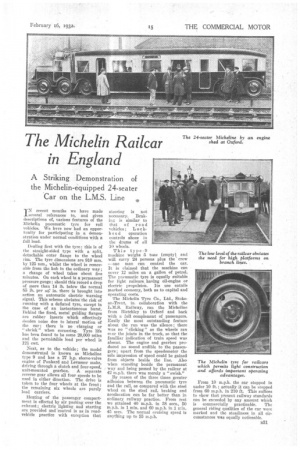The Michelin Railcar in England
Page 49

If you've noticed an error in this article please click here to report it so we can fix it.
A Striking Demonstration of the Michelin-equipped 24-seater Car on the L.M.S. Line
TN recent months we have made _L several references to, and given descriptions of, various features of the Michelin pneumatic tyre for rail vehicles. We have now had an opportunity for participating in a demonstration under normal conditions with a full load.
Dealing first with the tyre ; this is of the straight-sided type with a split, detachable outer flange to the wheel rim. The tyre dimensions are 910 mm. by 125 mm., whilst the wheel is removable from the hub in the ordinary way ; a change of wheel takes about five minutes. On each wheel is a permanent pressure gauge ; should this record a drop of more than 14 lb. below the normal 85 lb. per sq, in. there is brought into action an automatic electric warning signal. This scheme obviates the risk of running with a deflated tyre, except in the case of an instantaneous burst. Behind the fixed, metal guiding flanges are rubber inserts which effectively deaden noise due to lateral motion of the car ; there is no clanging or
shriek" when cornering. Tyre life has been found to be some 20,000 miles and the permiesible load per wheel is 121 cwt.
Next, as to the vehicle; the model demonstrated is known as Micheline type 9 and has a 27 h.p. sleeve-valve engine of Panhard and Levassor make, driving through a clutch and four-speed, unit-mounted gearbox. A separate reverse gear allows all four speeds to be used in either direction. The drive is taken to the four wheels at the front; the remaining six wheels are purely load carriers.
Heating of the passenger compartment is effected by air pasting over the exhaust; electric lighting and starting are provided and 'control is as in roadvehicle practice with exception that steering is not necessary. Braking is similar to that of road vehicles ; L oc kheed operation controls shoes in the drums of all 10 wheels.
This type-9 machine weighs 5 tons (empty), and will carry 24 persons plus the crew —one man can control the car. It is claimed that the machine can cover 12 miles on a gallon of petrol. The pneumatic tyre is equally suitable for light railcars, having oil-engine or electric propulsion. Its use entails marked economy, both as to capital and operating costs. The Michelin Tyre Co., Ltd., Stokeon-Trent, in. collaboration with the L.M.S. Railway, ran the Micheline from 131etchley to Oxford and back with a full complement of passengers. Easily the most outstanding feature about the run was the silence; there was no " clicking " as the wheels ran over the joints in the track, so that the familiar indication of train speed was absent. The engine and gearbox produced no sound audible to the passengers; apart from the speedometer the sole impression of speed could be gained from objects beside the line. Also when standing beside the permanent way and being passed by the railcar at 92 m.p.h. there was merely a "swish."
By reason of the three times greater adhesion between the pneumatic tyre and the rail, as compared with the steel wheel on the steel rail, braking and acceleration can be far better than in ordinary railway practice. From rest we attained 40 m.p.h. in 88 secs., 50 m.p.h. in 1 min, and 60 m.p.h. in 1 min. 45 secs. The normal cruising speed is anything up to 55 m.p.h.
From 10 m.p.h. the car stopped in under 10 ft.; actually it can be stopped from 60 m.p.h. in 210 ft. This suffices to show that present railway standards can be exceeded by any amount which is commercially practicable. The general riding qualities of the car were marked and the steadiness in all circumstances was equally noticeable.




































































































